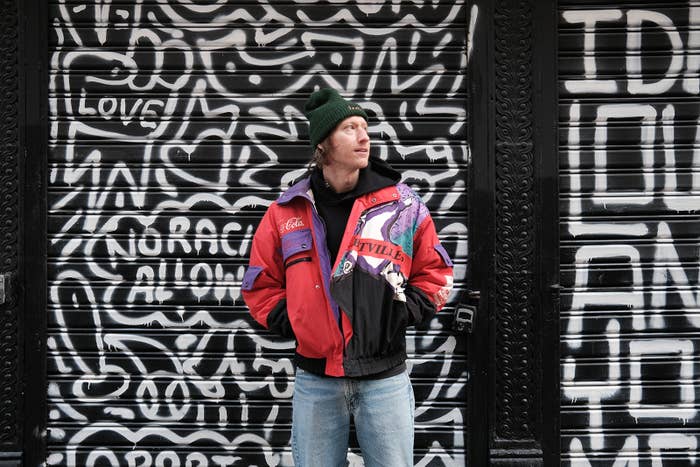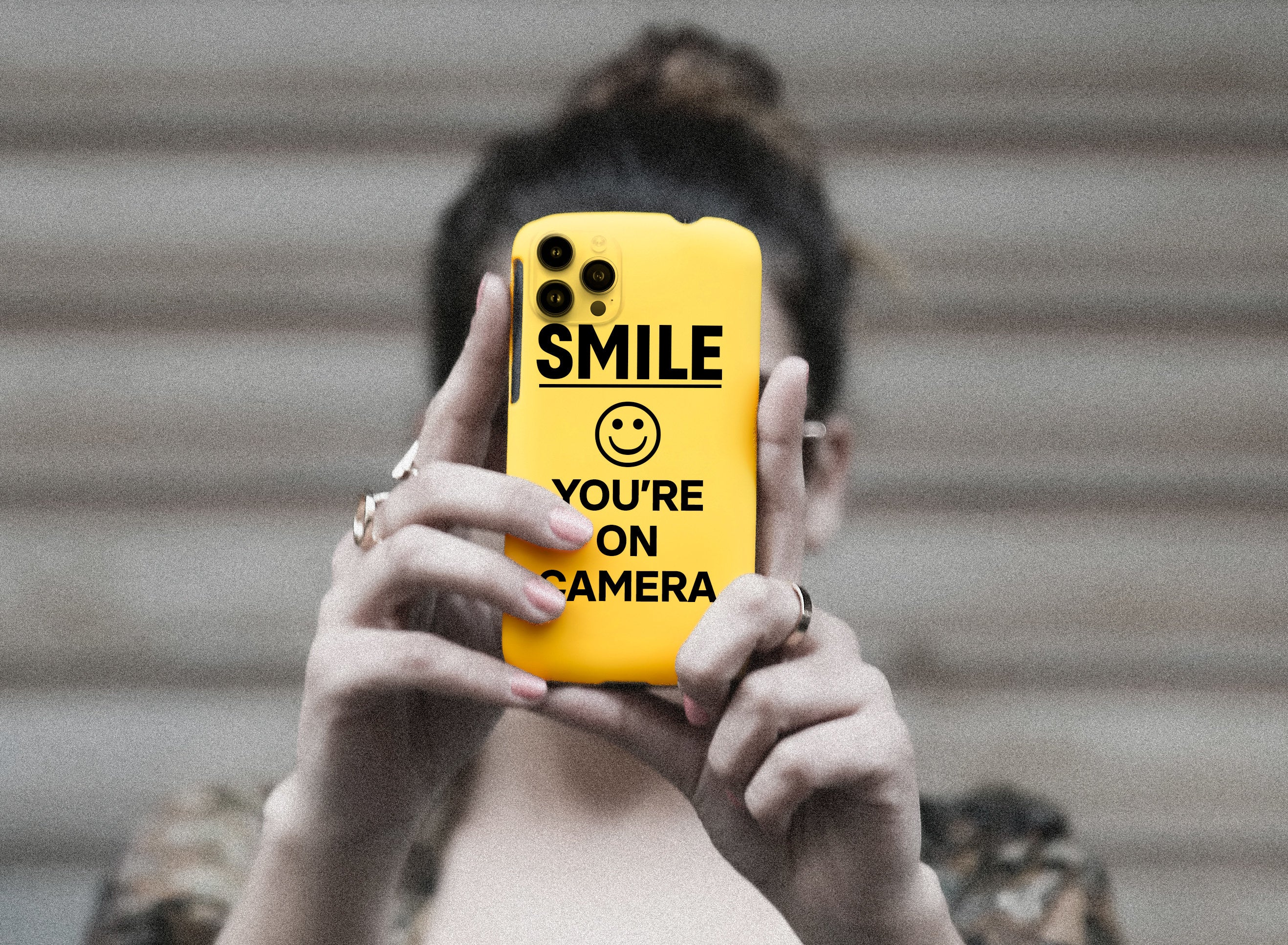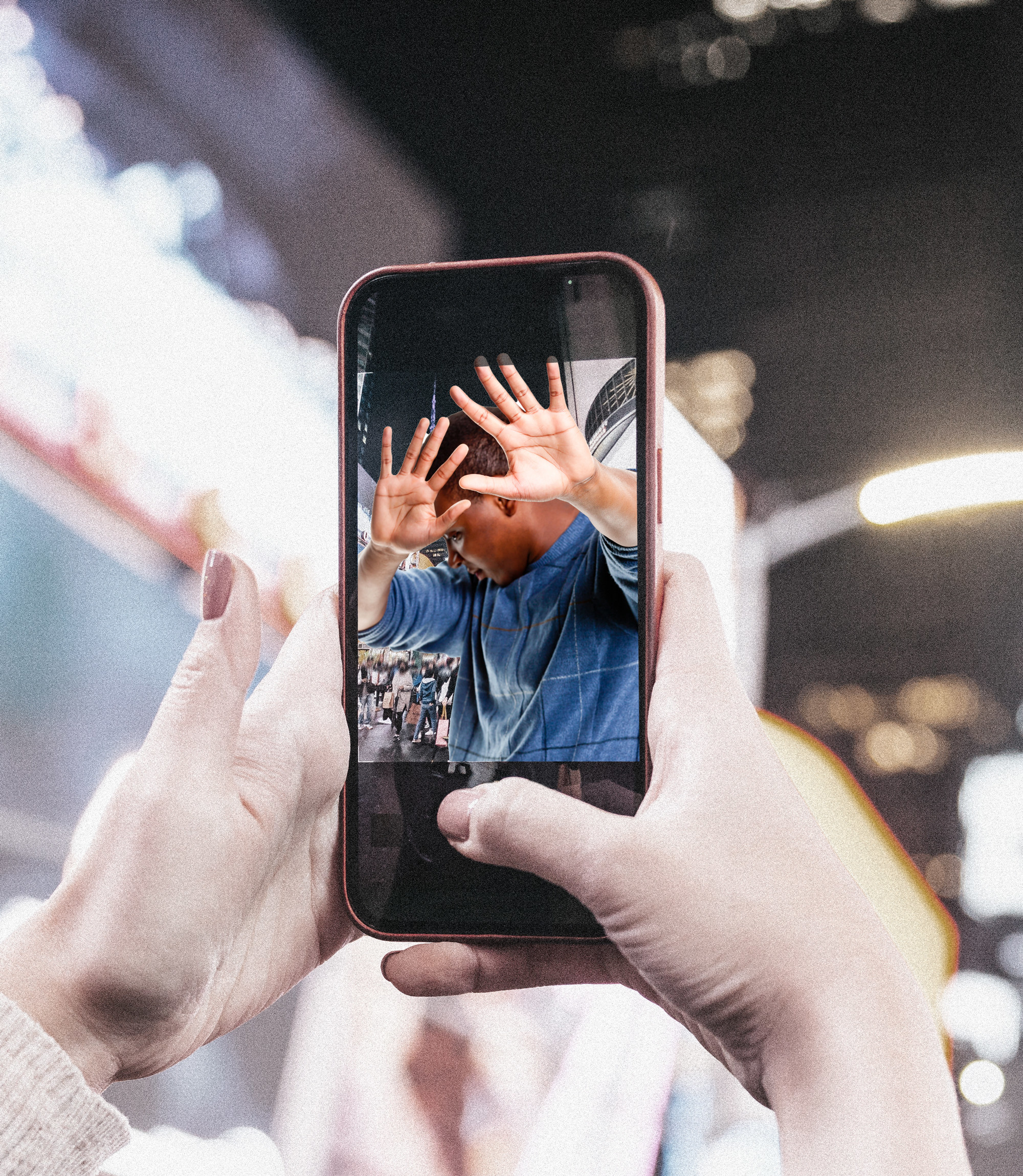Timothy Goodman was oblivious to the camera being pointed at him. It was September in New York, and Goodman, an artist and graphic designer, was near his art studio, getting lunch or walking home; he doesn’t remember exactly. What he didn’t realize, until days later when friends sent him a TikTok, was that he was being filmed by someone from inside a moving car.
The video shows Goodman and another man waiting to cross the street. You can’t see Goodman’s face because he’s looking down at his phone, but the man behind him looks right at the camera. The text overlaid on the video suggests that one of the men had lied to bail on a date and was caught in the act: “when he texts u that he can’t do dinner because he’s out of town for work but u see him crossing the streets while ur in ur Uber.”
When friends sent Goodman the TikTok, he was confused — though a little bemused — to find himself the subject of a viral video. But the premise was fake: He didn’t know the person who made the TikTok, Ellery Lee, and he was in a happy, long-term relationship with his girlfriend.

But nobody on TikTok knew that. In the comments, people viciously insulted Goodman and the other man’s appearance. Meanwhile, Lee was responding to commenters telling them to wait for the full story.
“She’s egging it on like I’m really her man and this whole thing was real,” Goodman told BuzzFeed News. “And then I got kind of upset.”
The video racked up more than a million views on TikTok before Lee finally removed it a few days later.
In a TikTok responding to Lee’s video, Goodman made an emphatic plea. “This is a viral video with hundreds of comments of people talking about how disgusting I look and how skinny I am, and how she can do so much better. And I would just say that like, maybe we don’t have to make fun of people’s appearances, complete strangers, online,” he said.
“Maybe we also shouldn’t be like, posting people — strangers — online without their consent.”
What happened to Goodman has become increasingly common in an age where camera phones are ubiquitous and the desire for internet clout is chronic. We film ourselves, we film our surroundings, we film the people we know and the people we don’t, and we post freely and carelessly. This is the age of panopticontent — everything is content for the creating, and everyone is a nonplayer character in my world.
TikTok exposes people to a sudden, mammoth level of popularity, and consequently an audience hungry to investigate, speculate, and scrutinize.
“We’re living in sort of a self-induced surveillance state, where no longer is it necessarily the government panopticon, but it’s now everyone else getting their phones out and filming and surveilling, constantly,” Jenna Drenten, an associate professor in the Quinlan School of Business at the Loyola University Chicago who studies digital consumer culture, told BuzzFeed News.
Our appetite to document and post — whether it’s ethical or not — is reinforced by the seduction of social media fame. There are whole genres of online content in which people are being recorded or photographed without their knowledge or consent — on the subway, at a shopping center, in a car, on the sidewalk, at a restaurant, at a bar. Many of these videos present strangers as NPCs, or nonplayer characters, an internet term referring to people who aren’t seen as fully realized individuals and are simply part of the backdrop. These strangers are displayed as a spectacle to gawk at and be judged by an audience of millions around the world: People experiencing homelessness are objects of pity and disgust. A couple making out in public are objects of ridicule.
“In the larger context of things, it’s just a big problem, like people will [want to] go viral at any cost these days,” Goodman said. “Doesn’t matter who’s the subject or what it might mean to their life.”
Lee, an influencer with 30,000 followers on TikTok, said her content is meant to be self-deprecating and relatable. She told BuzzFeed News that the last thing she expected when she posted her video was for it to get back to any of the people in it. But that’s the thing about TikTok; by virtue of the app’s For You page, users are served content from anyone, anywhere, and videos can go massively viral regardless of a creator’s follower count. It also exposes people to a sudden, mammoth level of popularity, and consequently an audience hungry to investigate, speculate, and scrutinize.

Documenting people in their everyday lives and turning it into online content is not new. Blogs like People of Walmart, which shared user-submitted photos of unsuspecting Walmart shoppers, were early iterations of this phenomenon in the late aughts.
But thanks to apps like TikTok, the reach of social platforms is larger than ever before, and our online social circles are far more expansive. We’re no longer just privy to the social media lives of our friends, family, acquaintances, and celebrities; we are now giving strangers access to our lives — and everyone in it — and inviting them to watch and participate.
“There’s sort of instant gratification and a reward for the person that can post that content,” Drenten said. “They get to have a viral video and become popular for a moment in time.”
Our ability to instantly film and post on social media has not just been a source of entertainment, it’s also been used as a powerful social tool. Ordinary citizens documenting police interactions or acts of discrimination has enabled us to hold people and institutions in power accountable, including if laws fail to do so. But turning the camera on each other for entertainment can lead people into ethically murky territory.
It’s generally legal to film and photograph people in public, and there’s little legal recourse for people unhappy about their image being captured in a public space. “It is a bit inevitable that we are constantly watching and being watched,” Drenten said. “In public spaces, your image is always up for grabs.”
Private citizens can bring a false light claim against someone for intentionally or recklessly misrepresenting their image in a highly offensive way, but those are high bars to clear and it costs a lot of money to take someone to court, Mark Bartholomew, a law professor at the University at Buffalo who focuses on online privacy, told BuzzFeed News. (Celebrities have a higher burden of proof when they bring a defamation claim against the paparazzi, for example, because they are voluntary public figures and generally have more resources to combat false narratives about themselves.)
“Once you’re in the public area, there’s a lot of freedom for people to record you without your permission,” Bartholomew said.
Although it is in our nature to want to self-document, social media often magnifies our worst tendencies.
And while it’s legally true that there is no expectation of privacy in public spaces, it’s reasonable for people to expect that their photo won’t be taken and shared online simply because they leave their house that day, said Casey Fiesler, an associate professor in the Department of Information Science at the University of Colorado Boulder, who specializes on information ethics and law, and online communities.
Although it is in our nature to want to self-document, social media often magnifies our worst tendencies, Bartholomew argued. “These entities like TikTok, they’re not rewarding thoughtful curation and documenting. They’re rewarding, sexy, controversial, snarky videos that generate views,” he said. “I think people have these good human impulses to curate, to document, to share, and the platform does help you do that. But at the same time, I think it pushes these darker impulses as well.”
TikTok has certainly emboldened our pursuit of attention, but viewers are not blameless here either. Every time we watch a video, share it with our group chats, write a comment, and post it on another platform, we are willing participants in an increasingly toxic ecosystem. TikTok’s For You page is engineered to distinguish between content you engage with and content you don’t, so if you’re served multiple videos of strangers being recorded, it’s likely because the app’s fiercely effective algorithm has figured out that that content occupies your attention.
In the grand scheme of our surveillance state, when public and private entities, including TikTok, pose a bigger threat to our privacy and harvest our data in troubling ways, maybe becoming the main character of the day online isn’t the end of the world. But the casual resignation around how our data is used may explain why we’re increasingly comfortable surveilling each other.
“If you’re constantly under watch, it sort of is more OK, I think, to point your camera at someone else without permission and post it,” Bartholomew said. “I think our sense of privacy is gradually declining.”
When Lee took out her phone to record that day in the Uber, she said she just randomly filmed people on the street and slapped a caption on the video without thinking twice. As her TikTok became viral, she saw that people were invested in the story and wanted to know more. So she went along with it, telling people to stay tuned for updates.
“It was just to play into that story because at the end of the day, it was a character I was playing on TikTok. You kind of like, want to [draw] them in,” she said. She frequently posts comedic videos about dating where she’s on the losing end, like dancing behind text that reads “me after he texts at 12am asking wyd after ghosting me for 3 months.” It’s a narrative she’s created for content — “I’m embarrassing myself.”
Lee’s viral video is an example of what Drenten calls story-making, a popular form of social media content in which fictionalized or speculative context is added. Story-making content can seem like an innocuous expression of main character syndrome (a self-absorbed person who identifies as the protagonist in their life), but it can also have unintended consequences, like in Goodman’s case.
After Goodman responded to her TikTok, it was flooded with comments criticizing her for filming strangers without their consent and for making up the story. Lee removed the TikTok and made an apology video. “I do agree that having consent is something that should be explored in all social media platforms. Please note that my intentions were never to hurt anyone’s feelings in the making of this video,” she said. (Lee later deleted that apology video too, after being criticized for saying consent should be “explored.”)
The backlash she received over that incident was intense, and she told BuzzFeed News that she got death threats. Though the experience has taught her to recenter herself and not others in her content, Lee thinks being filmed in public — with or without permission — is bound to happen.
“You can’t avoid it. Everyone has a smartphone and camera,” she said. “It’s what our generation does.”

Lilly Simon was coming home from work in July 2022 when a stranger filmed her on the subway. Simon has neurofibromatosis type 1, a genetic condition that causes tumors to grow along her nerves, which look like bumps on her skin. It was the height of the mpox outbreak in New York City, and the person who posted the TikTok zoomed in on the bumps on Simon’s skin and overlaid an emoji of a monkey and a question mark on the video, insinuating that she had mpox.
It’s unclear how much engagement that video received, but it was popular enough that Simon’s sister saw it days later and alerted her to it. By then, there was a flood of comments from people mocking her for wearing shorts and being out in public, even threatening her life.
When Simon saw the TikTok, she told BuzzFeed News her childhood memories of people making fun of her came rushing back. Then she got angry.
“I’ve always had to deal with people like the people in the comments section of this video, and, of course, the person who posted this,” Simon said in a TikTok responding to that video. “I will not let any of you all reverse years of therapy and healing that I had to endure to deal with the condition and, of course, with this around people like you.”
Simon received a lot of support on her TikTok, and she told BuzzFeed News that she’s proud to have helped raise awareness about her condition. But she still struggled with being known for something she tried her whole life to hide.
“The internet goes on forever,” Simon said. “There’s no reversing that.”
Though the person who posted it reached out to her on TikTok, Simon said she ignored their efforts to get in touch. “I don’t really remember some of the things that he said,” she told BuzzFeed News. “I don’t think ‘sorry’ was one of them.” The TikTok was eventually taken down. But whether or not the original poster apologized, Simon said the damage was already done.
“The video is out there. It’s shared. It’s posted. The internet goes on forever,” Simon said. “There’s no reversing that.”
Even if the content posted isn’t overtly cruel, it can still be blatantly self-serving at the expense of others. Harrison Pawluk, an Australian TikToker with 3.4 million followers, went viral last June for recording himself giving flowers to a woman at a shopping center, framing it as an act of kindness. In his video, he approaches the woman and asks her to hold a bouquet of flowers as he puts his jacket on. Then he walks away, leaving the flowers with her.
“I hope this made her day better [heart emoji],” he wrote in the caption, along with the hashtag #wholesome.
Pawluk added dramatic music to make the video more emotionally charged, and his stunt was praised by commenters as “beautiful” and “sweet.” But the woman who was filmed, Maree (she declined to share her last name), later told ABC Radio Melbourne that she never agreed to participate, and she felt “dehumanized” by the encounter.
“These artificial things are not random acts of kindness,” she said. “He interrupted my quiet time, filmed and uploaded a video without my consent, turning it into something it wasn’t, and I feel like he is making quite a lot of money through it.”
More than 13 million people liked the video. Pawluk apologized after Maree’s interview aired, but said he won’t stop making videos that “inspire” people to “do something good.” That video continues to live on his TikTok account.
Content like Pawluk’s is meant to elevate the creator as the protagonist in the story, Drenten said. “At the end of the day, it's making the content creator the hero of the story,” she said, “because they get all the eyeballs on the internet and they get the attention at the cost of somebody else.”
And being surreptitiously documented can be unpleasant no matter your level of fame. Keke Palmer tweeted about a fan who filmed her in public even though she turned down their repeated request for photos. Bad Bunny hurled a fan’s phone in the water after they tried to take a selfie with him.
When Sarah Isenberg, a 24-year-old microinfluencer who mostly posts fashion content on her Instagram and TikTok, was recognized in a stranger’s vlog of their day in New York City, she said she felt uneasy. She was filmed crossing a street in someone else’s TikTok and while her face isn’t shown in the video, a follower clocked her outfit — which she had shared on Instagram — and tagged her in it.
Isenberg is no stranger to people recognizing her from social media or asking for a photo of her outfit. But this felt different, she said.
“I felt really uncomfortable that, one, somebody has taken this video of me without my knowledge and without my consent to post it to the internet, and now people on the internet who I don’t know are recognizing me in this video without even my face being in it,” she told BuzzFeed News.
Isenberg knew the person who filmed her meant no harm. Less than 6,000 people saw the TikTok, a relatively minuscule amount of views for a video on the app. But the experience unnerved her. It was as if she was being watched, but she didn’t know from where and by whom.
“In the plainest of terms, it kind of felt Truman Show–y,” she said, “where everybody else is in on this, but I’m not.” ●
